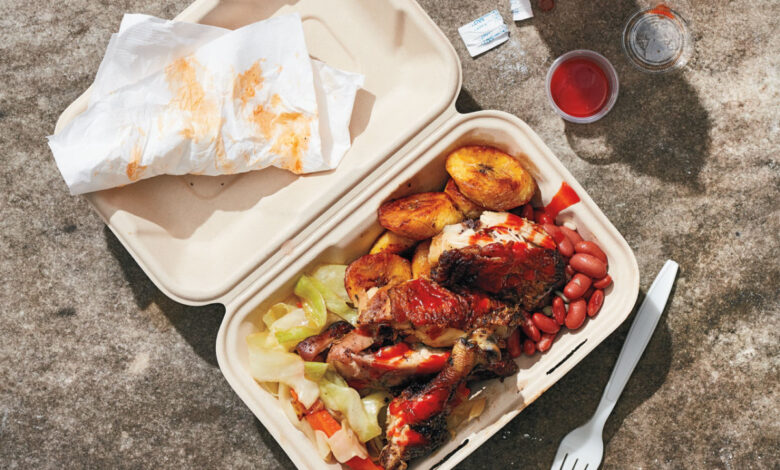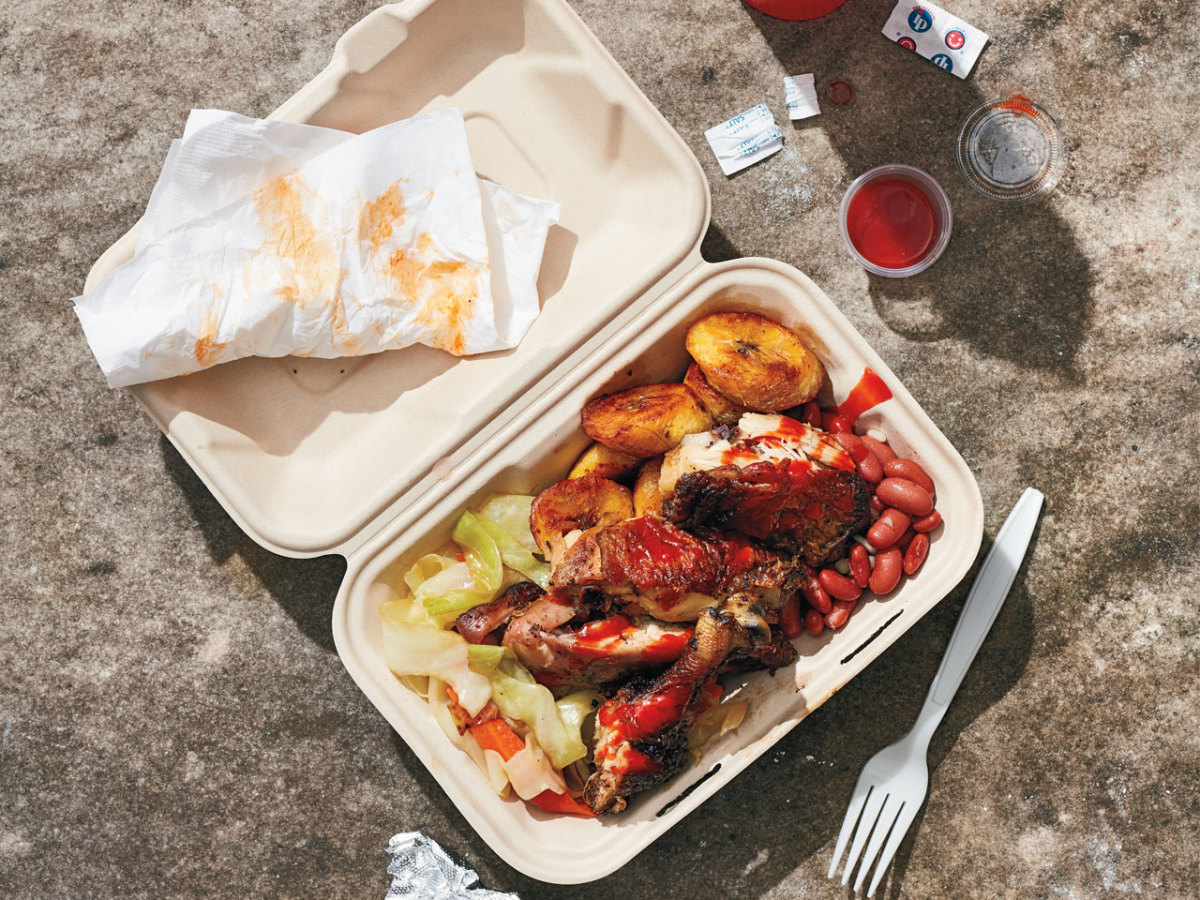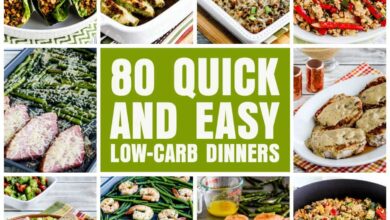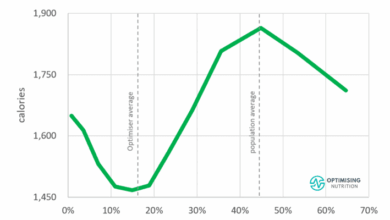
Can we make food trucks healthier? This isn’t just a question of nutrition; it’s about reimagining the fast-food experience. From sourcing fresh, local ingredients to crafting innovative recipes and controlling portion sizes, there’s a surprising potential to elevate the food truck scene. We’ll delve into the practical steps, explore the challenges, and investigate successful case studies to see if we can transform these mobile eateries into healthier, more sustainable options.
We’ll explore everything from defining what constitutes a “healthier” food truck to understanding the consumer perspective and marketing strategies that can help these trucks succeed in a competitive market. This isn’t about sacrificing flavor or convenience, but rather about finding a way to satisfy cravings while prioritizing well-being.
Defining “Healthier” Food Trucks: Can We Make Food Trucks Healthier

Food trucks, while offering convenience and diverse culinary experiences, often fall short in the realm of healthy eating. This necessitates a clear definition of “healthier” food trucks, encompassing various aspects beyond just the absence of unhealthy ingredients. A critical evaluation of nutritional content, sourcing practices, preparation techniques, and portion control is essential for consumers to make informed choices.Defining “healthier” in the context of food trucks requires a multifaceted approach.
It’s not simply about avoiding certain ingredients, but about actively incorporating nutrient-rich alternatives and adopting responsible preparation methods. This holistic perspective fosters a healthier eating environment, encouraging consumers to make mindful dietary decisions.
Nutritional Aspects of Healthier Food Trucks
Quantifying the nutritional value of food truck offerings is vital for consumers and regulatory bodies alike. A comprehensive assessment should consider macronutrients (protein, carbohydrates, and fats), micronutrients (vitamins and minerals), and calorie counts. Utilizing standardized nutrition databases and conducting nutritional analyses of specific menu items can provide a detailed breakdown of the nutritional content. For example, a detailed nutritional label for a “healthier” burger might specify the exact amount of protein, fiber, and healthy fats, along with the calorie count, per serving.
Ingredient Sourcing Practices
The origin and quality of ingredients play a crucial role in the overall health profile of food truck offerings. Prioritizing locally sourced, organic, and sustainable ingredients is paramount for reducing the environmental impact and enhancing the nutritional value of the food. Emphasis should be placed on ingredients that are free from artificial additives and preservatives, while also ensuring they align with ethical sourcing practices.
This commitment to quality ingredients fosters trust and encourages consumers to choose healthier options.
Preparation Methods and Portion Sizes
Preparation methods significantly influence the nutritional value of food truck meals. Opting for healthier cooking techniques, such as grilling, baking, or steaming, instead of frying, reduces the calorie and fat content. Controlling portion sizes is equally important; excessive portion sizes can lead to overconsumption, even if the ingredients are healthy. Clear portion control strategies, accompanied by appropriate signage and menu descriptions, can help consumers make informed choices.
Portion size consistency across the menu can aid in monitoring nutritional intake.
Comparison with Traditional Fast Food
Traditional fast-food restaurants often prioritize taste and speed over nutritional value. They frequently use processed ingredients, high-fat cooking methods, and oversized portions. Conversely, healthier food trucks emphasize fresh, whole ingredients, healthier cooking methods, and controlled portion sizes. This contrast underscores the potential of food trucks to provide a more nutritious alternative to conventional fast-food options.
Nutritional Content Comparison Table
| Item | Fast Food | Healthier Food Truck | Nutritional Difference |
|---|---|---|---|
| Burger | Typically includes a high-fat patty, processed buns, and excess cheese, leading to a high calorie and saturated fat count. | Features a leaner protein source like turkey or chicken breast, whole-wheat buns, and low-fat cheese alternatives, reducing overall fat and calorie intake. | Significant reduction in saturated fat, calories, and potentially sodium content. |
| Fries | Usually deep-fried, resulting in a high-calorie and high-fat dish. | Often baked or air-fried, offering a healthier alternative with significantly lower fat content. | Substantial reduction in fat, calories, and trans fats. |
Health Guidelines and Regulations
Health guidelines and regulations vary across different locations, impacting the ways in which healthier food trucks operate. Local health departments establish standards for food safety, ingredient handling, and preparation methods. These guidelines ensure food safety and help consumers make informed decisions. Understanding these regulations is crucial for both food truck operators and consumers to maintain a high standard of food safety and nutritional quality.
Compliance with local regulations is paramount.
Ingredient Sourcing and Preparation
Food trucks, with their dynamic nature and immediate customer interaction, are uniquely positioned to embrace innovative approaches to ingredient sourcing and preparation. By prioritizing healthier options, they can not only improve public health but also establish a strong brand identity and foster customer loyalty. The choices made in these areas directly impact the nutritional value and environmental footprint of the food served.The key to a healthier food truck is a commitment to high-quality ingredients, sustainable practices, and thoughtful preparation methods.
This involves careful selection of suppliers, consideration of transportation and storage, and the development of recipes that utilize healthier alternatives. A shift towards local and organic sourcing, along with creative recipe adaptations, can create a win-win for both the business and the community.
Innovative Strategies for Sourcing Healthier Ingredients
Food trucks can partner with local farms and producers to source fresh, seasonal produce. Direct relationships build trust and guarantee the quality of ingredients. This reduces reliance on long-distance transport, minimizing environmental impact and maximizing freshness. Additionally, exploring partnerships with urban farms and community gardens can be a sustainable and innovative approach. Such collaborations support local economies while offering the highest quality, freshest ingredients.
Sustainable and Ethical Sourcing Methods
Prioritizing ethical sourcing means considering the entire supply chain. Transparency in the origin and production of ingredients is crucial. This includes traceability of ingredients, fair labor practices in farms and processing plants, and environmentally friendly farming methods. Certifications like organic, fair trade, and sustainable aquaculture can guide food trucks in their sourcing decisions. Transparency in the supply chain builds trust with customers who are increasingly aware of ethical and sustainable practices.
Locally Sourced Ingredients vs. Imported
Locally sourced ingredients generally have a shorter transportation time, resulting in lower environmental impact and better nutritional value. Freshness is paramount, impacting the flavor and nutrients in the final product. However, availability and pricing of certain ingredients might vary depending on seasonality and location. Imported ingredients, while sometimes more affordable or readily available, often involve substantial transportation distances and may come with a greater environmental cost.
A balanced approach, focusing on seasonal, local ingredients while strategically incorporating imported items when necessary, can achieve a good compromise between taste, affordability, and sustainability.
Impact of Cooking Methods on Nutritional Value
Different cooking methods have varying effects on the nutritional content of ingredients. For example, steaming and baking often retain more nutrients compared to frying. Reducing reliance on deep frying or high-heat methods in favor of healthier alternatives like grilling, baking, or stir-frying can significantly improve the nutritional profile of food truck dishes. This requires experimentation and recipe development to find balanced and flavorful solutions.
Adapting Existing Recipes for Healthier Ingredients
Existing recipes can be adapted to accommodate healthier ingredients without sacrificing taste. Substituting refined grains with whole grains, using lean proteins instead of processed meats, and incorporating a variety of vegetables and fruits are crucial steps. This includes a shift from processed foods to whole, unprocessed options. By understanding the nutritional profile of ingredients, food trucks can create innovative dishes that meet the needs of health-conscious consumers.
For example, using quinoa instead of rice, or lean ground turkey instead of beef, can significantly enhance the nutritional value of a dish.
Healthier Substitutions for Traditional Ingredients
Replacing refined sugar with natural sweeteners like honey or maple syrup, or swapping white bread for whole-wheat bread, can greatly improve the nutritional content of meals. Substituting processed meats with lean protein sources like fish, chicken, or beans, and opting for low-fat dairy alternatives can reduce saturated fat intake. By incorporating these substitutions, food trucks can provide nutritious meals that align with healthier dietary preferences.
Menu Design and Portion Control
Crafting a compelling and healthy menu for a food truck requires careful consideration of both taste and nutritional value. A well-designed menu, alongside appropriate portion control, can significantly impact customer satisfaction and contribute to a positive health message. It’s crucial to emphasize the benefits of each dish while maintaining an appealing presentation that encourages customers to make healthier choices.Creating a menu that’s both delicious and nutritious is key to attracting customers.
This involves more than just listing ingredients; it’s about showcasing the meal as a complete, balanced experience. This section dives into the art of menu design, portion control strategies, and clear labeling for healthier food truck options.
Sample Healthy Food Truck Menu
This sample menu focuses on balanced meals, portion control, and visually appealing presentation.
- Mediterranean Quinoa Bowl: Roasted vegetables (zucchini, bell peppers, eggplant), grilled chicken or chickpeas, fluffy quinoa, and a vibrant lemon-herb vinaigrette. This dish highlights lean protein, complex carbohydrates, and an abundance of vitamins and minerals.
- Black Bean Burgers: Homemade black bean burgers on whole-wheat buns with lettuce, tomato, avocado, and a light chipotle mayo. These burgers are a good source of fiber and protein, while the fresh toppings provide added vitamins and healthy fats.
- Grilled Salmon with Roasted Asparagus and Brown Rice: Fresh, grilled salmon, alongside roasted asparagus and brown rice, creates a light yet satisfying meal. This dish is a powerhouse of omega-3 fatty acids, fiber, and protein. It emphasizes lean protein and healthy fats.
- Fruit & Yogurt Parfait: Layers of Greek yogurt, mixed berries, granola, and a drizzle of honey. This delightful and healthy option provides a good source of calcium, protein, and antioxidants.
Visual Appeal and Health Benefits
Visual presentation plays a significant role in enticing customers. Bright, appealing colors, creative plating, and clear descriptions of ingredients and health benefits are important factors to consider. A visually appealing menu can encourage customers to choose dishes that align with their health goals.
Portion Control Strategies
Portion control is essential for maintaining a healthy diet. Implementing portion control strategies can promote healthier eating habits for customers.
| Menu Item | Small Portion | Medium Portion | Large Portion |
|---|---|---|---|
| Mediterranean Quinoa Bowl | 1/2 cup quinoa, 4 oz. chicken/chickpeas, 1/2 cup vegetables | 1 cup quinoa, 6 oz. chicken/chickpeas, 1 cup vegetables | 1 1/2 cups quinoa, 8 oz. chicken/chickpeas, 1 1/2 cups vegetables |
| Black Bean Burgers | 1 burger patty, 1 whole-wheat bun | 2 burger patties, 2 whole-wheat buns | 3 burger patties, 3 whole-wheat buns |
| Grilled Salmon | 4 oz. salmon fillet | 6 oz. salmon fillet | 8 oz. salmon fillet |
| Fruit & Yogurt Parfait | 1/2 cup yogurt, 1/2 cup berries, 1/4 cup granola | 1 cup yogurt, 1 cup berries, 1/2 cup granola | 1 1/2 cups yogurt, 1 1/2 cups berries, 3/4 cup granola |
Clear Labeling and Nutritional Information
Clear labeling is crucial for transparency. Nutritional information should be readily available for each menu item. This allows customers to make informed choices based on their dietary needs.
Options for Portion Control
Various options can support portion control. Using smaller plates, offering smaller portions as an option, and providing clear visual cues regarding portion sizes are all effective strategies.
“Offering smaller portion options without sacrificing taste or presentation can encourage customers to eat less, but still enjoy a satisfying meal.”
Marketing and Consumer Perception
Attracting customers to healthier food trucks requires a nuanced approach that goes beyond simply highlighting the absence of unhealthy ingredients. A successful marketing strategy must resonate with consumers’ desires for both health and enjoyment. The key is to present healthier options not as sacrifices but as delicious and satisfying alternatives to traditional fast food. This involves understanding consumer motivations, crafting compelling messaging, and establishing a brand identity that champions wellness without compromising taste or convenience.
Crafting a Compelling Brand Identity
A strong brand identity is crucial for differentiating healthier food trucks from the competition. This includes a memorable name, logo, and visual aesthetic that convey a sense of freshness, health, and deliciousness. The brand should reflect the unique values and offerings of the truck, emphasizing the high-quality ingredients and mindful preparation. For instance, a truck focusing on locally sourced, organic produce might utilize earthy tones and rustic imagery in its branding.
A truck prioritizing unique flavor combinations might employ vibrant colors and playful graphics. The brand should also convey a story that resonates with the target audience, whether it’s a commitment to sustainability, local sourcing, or innovative culinary techniques.
Highlighting Health Benefits
Emphasizing the health benefits of food truck offerings doesn’t necessitate a clinical approach. Instead, focus on the positive aspects of the ingredients and preparation methods. For example, instead of stating “low in fat,” highlight the use of lean proteins and fresh vegetables. Instead of “high in fiber,” emphasize the satisfying and filling nature of whole grains and fruits.
The language should be engaging and appealing, connecting the health benefits to the overall experience of enjoying the food. Showcase the nutritional value in a digestible and approachable manner, using clear, concise, and attractive visuals. Avoid jargon and focus on simple, relatable benefits like “energy boost,” “delicious and nutritious,” or “fuel your day.”
Addressing Consumer Concerns
Consumers often worry that healthier options will compromise taste and convenience. Food trucks can effectively address these concerns by emphasizing the quality of ingredients and creative culinary techniques. Showcase the unique flavor combinations and the effort put into developing recipes that are both healthy and delicious. Highlight the speed and efficiency of the ordering and service process, ensuring a convenient experience.
Offer a variety of options to cater to different preferences, while clearly labeling each item’s nutritional profile. This allows customers to make informed choices without feeling pressured or limited.
Food trucks are a convenient, often delicious, part of modern life. But can we make them healthier? The question isn’t just about portion sizes and added sugars; it’s also about the potential for early detection of health issues like colon cancer. Knowing how to detect colon cancer earlier and treat it later is crucial for a healthy population.
detecting colon cancer earlier treating later is a vital part of the conversation, and understanding those factors can help us make food trucks healthier options for everyone. Ultimately, it’s all about making healthier choices available, both for the food and the eaters.
Comparing Marketing Strategies
Traditional fast-food restaurants often focus on aggressive advertising, large-scale promotions, and creating a sense of familiarity and comfort. Conversely, healthier food trucks can leverage social media marketing, highlighting the freshness of ingredients, unique flavors, and commitment to sustainability. They can engage with their target audience through interactive events, social media contests, and community partnerships. Building a loyal customer base through personalized experiences and transparency about their sourcing and preparation is also key.
Successful Marketing Campaigns
Several successful food truck campaigns highlight the importance of authenticity and transparency. For example, a truck focusing on vegan cuisine might partner with local farmers’ markets to showcase their products and build trust with the community. Another example could be a truck that features locally sourced ingredients, focusing on its story and ethical sourcing practices in their marketing materials.
These strategies resonate with consumers seeking healthier options while supporting local businesses and sustainable practices.
Effective Slogans and Branding
Effective slogans and branding communicate the health message concisely and engagingly. Examples include:
- Fuel Your Body, Fuel Your Day
- Fresh Flavors, Healthy Choices
- Taste the Difference, Feel the Difference
- Good Food, Good for You
These slogans and brands emphasize the combination of taste and well-being, appealing to a broader customer base.
Challenges and Opportunities
The path to healthier food trucks isn’t paved with smooth sailing. While the potential for a vibrant and nutritious food truck scene is undeniable, several hurdles must be overcome. These range from the practical considerations of sourcing ingredients to the more nuanced challenge of shifting consumer perceptions. Understanding these challenges and opportunities is key to fostering a sustainable and successful healthier food truck industry.The journey towards healthier food trucks is not without its obstacles.
Thinking about how to make food trucks healthier? It’s a tricky issue, but maybe a parallel can be drawn to how our grocery shopping habits have changed during the pandemic. Grocery shopping and coronavirus has highlighted the importance of fresh produce and mindful choices, which could be a great starting point for healthier food truck options.
Ultimately, can we make food trucks healthier? Yes, by learning from the shifts in consumer habits, we might just find the answers we need.
From ingredient sourcing and preparation to menu design and consumer perception, each aspect presents its own set of difficulties. However, these challenges are also opportunities for innovation, growth, and a more sustainable food system. Clever solutions and a commitment to meeting evolving consumer demands will be crucial to navigating these obstacles.
Cost Considerations
Ingredient sourcing for healthier options often comes at a higher price point than traditional fare. Organic produce, sustainably raised proteins, and locally sourced ingredients can significantly impact the bottom line. This often requires careful budgeting and strategic partnerships to maintain profitability. For example, a food truck serving locally sourced, organic vegetables might find its cost of goods sold (COGS) higher than a truck relying on mass-produced, less expensive ingredients.
This price difference must be factored into menu pricing and operational strategies.
Availability of Ingredients
The availability of fresh, healthy ingredients can vary depending on seasonality and regional factors. Food trucks relying on specific seasonal produce or certain types of sustainably raised protein might experience supply chain challenges during off-seasons. Furthermore, access to local farmers markets and sustainable suppliers can vary widely across different locations. This necessitates a flexible menu design and proactive ingredient sourcing strategies to mitigate these fluctuations.
Consumer Preferences
Shifting consumer preferences towards healthier options isn’t always straightforward. While many consumers are seeking healthier choices, there’s a range of preferences and expectations. Not everyone is ready to fully embrace a completely plant-based or organic menu. Food trucks need to offer a variety of options that cater to different dietary needs and preferences, while still highlighting the health benefits.
The challenge lies in balancing the demand for healthier food with the desire for familiar tastes and flavors.
Innovation and Growth Opportunities
Food trucks are ideally positioned to leverage innovation in the healthier food truck space. They can pioneer new menu items using creative combinations of ingredients, new cooking techniques, and innovative food preparation methods. This could involve creating plant-based alternatives to popular meat dishes, or introducing new healthy snacks and beverages. A food truck focusing on gluten-free, vegan, or keto options could capitalize on these growing dietary trends.
Partnerships and Collaborations
Collaboration between food trucks and local farms, sustainable suppliers, and even health organizations can create synergistic opportunities. These partnerships can offer access to affordable, high-quality ingredients, provide marketing opportunities, and build a community around healthy eating. A partnership with a local farmers market, for example, can provide access to fresh produce and create a direct connection with customers.
Economic Viability
The economic viability of healthier food truck options hinges on several factors, including pricing strategies, efficient sourcing, and effective marketing. While healthier options may have a higher COGS, strategic pricing and portion control can maintain profitability. Marketing efforts can highlight the nutritional value and health benefits to attract customers willing to pay a premium for quality ingredients.
Thinking about how we can make food trucks healthier? It’s a tricky challenge, but maybe, just maybe, we can find some innovative ways to do it. Recent research shows that our brains are surprisingly adaptable, with new brain cells continuing to form even as you age, new brain cells continue to form even as you age.
This suggests we can also adapt our food choices and the way we approach food truck menus. Perhaps a focus on fresh ingredients and healthier options will become the new norm for food trucks. It’s all about finding balance and making positive changes.
Impact of Health Trends, Can we make food trucks healthier
Health trends play a pivotal role in shaping the future of food trucks. Consumers are increasingly seeking convenient and healthy meal options. Food trucks that embrace these trends and cater to specific dietary needs and preferences will be better positioned to thrive. For example, a rise in popularity of plant-based diets could lead to a surge in demand for vegetarian and vegan food trucks.
The challenge for food trucks will be to adapt to evolving trends while maintaining their unique identity.
Case Studies of Successful Healthier Food Trucks

Food trucks, once synonymous with greasy burgers and sugary drinks, are increasingly embracing healthier options. This shift reflects a growing consumer demand for nutritious and delicious food on the go. Successful healthier food trucks demonstrate not only a commitment to better ingredients but also a keen understanding of customer preferences and effective marketing strategies. Their stories offer valuable insights for aspiring food truck entrepreneurs looking to carve a niche in the competitive food scene.This section dives deep into successful healthier food truck models, analyzing their strategies, from ingredient sourcing and menu design to customer engagement and marketing tactics.
The goal is to uncover common threads of success and highlight the unique approaches that resonate with modern consumers.
Successful Models and Their Strategies
Several food trucks have effectively implemented healthier practices while maintaining profitability and customer loyalty. Their strategies often revolve around a combination of fresh, locally sourced ingredients, creative menu items, and targeted marketing campaigns.
Ingredient Sourcing and Preparation
A key to success lies in the quality and sourcing of ingredients. Many successful trucks partner with local farms or suppliers to obtain fresh, organic produce and sustainable proteins. This not only enhances the nutritional value of the food but also builds a stronger connection with the community. Thorough preparation methods, like precise portioning and controlled cooking techniques, play a crucial role in maintaining both flavor and nutritional integrity.
For instance, some trucks use innovative cooking methods like sous vide to ensure the delicate flavor and nutrients are preserved in their dishes.
Menu Design and Portion Control
Clever menu design is crucial. Instead of simply removing unhealthy items, successful trucks introduce creative alternatives that are both delicious and nutritious. They often highlight lean proteins, whole grains, and fresh vegetables. Portion control is equally important. By offering smaller, but satisfying portions, trucks can encourage healthier eating habits without compromising customer satisfaction.
For example, some trucks offer customizable bowls or salads where customers can choose their desired protein and vegetable combinations.
Marketing and Consumer Perception
Effective marketing is vital to attract and retain customers. Many successful trucks emphasize their commitment to healthy ingredients and sustainability in their branding and messaging. They often highlight the nutritional benefits of their food and use social media platforms to engage with customers. Transparency about ingredient sourcing and preparation is another key element that fosters trust and customer loyalty.
For example, some trucks use Instagram to showcase their farm-to-table practices, highlighting the freshness and quality of their ingredients.
Comparative Analysis of Approaches
Different healthier food trucks have adopted various approaches. Some focus on vegetarian or vegan options, while others emphasize balanced meals with lean proteins and complex carbohydrates. The best approach depends on the specific target market and the overall brand identity.
Unique Menu Items
Some healthier food trucks have developed truly unique menu items that have resonated strongly with customers. These items often combine familiar flavors with healthier ingredients. For example, a truck specializing in vegan cuisine might offer a flavorful “Beyond Burger” on a whole-wheat bun with a side of roasted sweet potato fries.
Customer Engagement and Feedback
Successful food trucks actively engage with customers, gathering feedback and tailoring their offerings accordingly. Customer reviews and surveys provide invaluable insights into preferences and areas for improvement.
| Food Truck Name | Health Approach | Customer Reviews |
|---|---|---|
| “The Green Grub” | Focuses on organic, locally sourced ingredients, offering vegetarian and vegan options. | “Delicious and healthy options. Love the fresh produce!” “Great place to grab a quick and nutritious lunch.” |
| “Fuel Up” | Offers balanced meals with lean proteins, whole grains, and fresh vegetables, with portion control. | “Portion sizes are perfect. The meals are satisfying and energizing.” “I love the variety of options for different dietary needs.” |
| “The Conscious Cuisine” | Emphasizes sustainable practices, uses seasonal ingredients, and features innovative menu items. | “Amazing flavors, great for those looking for something different.” “I appreciate their commitment to sustainability and health.” |
Last Word
Ultimately, can we make food trucks healthier? The answer is a resounding maybe, but certainly a hopeful yes. By focusing on sustainable sourcing, innovative recipes, and a consumer-centric approach, we can pave the way for a healthier, more flavorful food truck experience. It’s a challenge, but the potential rewards are immense, promising a brighter future for both the industry and our health.





